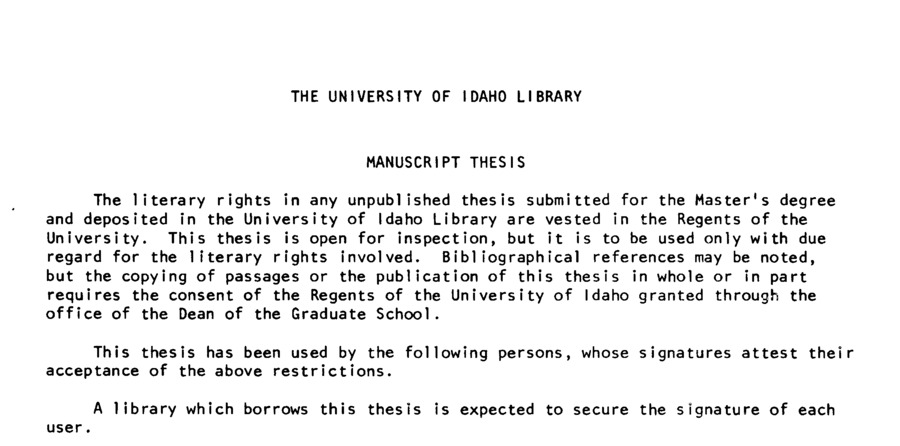PDF
Water quality along the South Fork of the Coeur d'Alene River 1966-1988 Item Info
- Title:
- Water quality along the South Fork of the Coeur d'Alene River 1966-1988
- Authors:
- Callcott, Susan B.
- Contributors:
- Idaho Water Resources Research Institute; IWRRI
- Date:
- 1989-04
- Description:
- Since 1890, mining of lead, silver and zinc has occurred in the Coeur D'Alene mining district. In the early days, jig tailings containing sphalerite and other heavy metal sulfides were discharged directly into the South Fork Coeur D' Alene River resulting in the elimination of aquatic life. Over the past 20 years, water quality legislation and modern milling techniques have combined to reduce sediment load and eliminate point source pollution from mine and mill sites, thereby improving the water quality along the South Fork. However, ''background'' levels of metals continue to pose problems for aquatic life in the river. This project recorded 18 sampling stations along the South Fork and Main Stem of the Coeur D' Alene River over a six month period; these values are compared to the metal concentrations reported in historic data collected by Mink (1969) and the EPA (Environmental Protection Agency) (1972-1984). The sampling station at Cataldo on the Main Stem and the stations upstream of Wallace on the South Fork did not exhibit excessive concentrations of the elements analyzed. Zinc displayed the highest overall concentrations during the study period; it exceeded toxicity limits for the survival of aquatic life. Station 12, located downstream of Smelterville Flats, exhibited the highest consistent concentration of zinc along the river. The highest zinc concentrations of all occurred in March from overland runoff through tailings, from the smelter dust on the land surface mixed with runoff, from the Smelterville Flats aquifer, and in July from groundwater inflow. May displayed the lowest overall zinc concentration during the sampling period. Past EPA studies indicate that cadmium and lead, although declining in concentration, still exceed EPA toxicity limits for the survival of fish along the South Fork. Since 1980, zinc levels at Smelterville Flats exceeded EPA's standard drinking levels. Although still above chronic levels for aquatic life, zinc concentrations are on the decline. Zinc levels at Cataldo have declined steadily since 1976 and have not exceeded drinking standard limits. The 1988 data compared to Mink's data from 1969 at Cataldo on the Main Stem indicate somewhat of a decrease in zinc concentrations. Station 12 at Smelterville Flats is variable for 1969 and 1988; but the majority of the 1988 zinc concentrations are lower than Mink's data, particularly during July and August. EPA bioassays conducted in 1986 record a number of benthic insect species living along the South Fork; a good return of game fish downstream of the South Fork confluence has been detected in the Main Stem of the Coeur D' Alene River. Thus, an overall improvement occurred over the past 20 years along the South Fork of the Coeur D' Alene River.
- Subjects:
- water quality heavy metals zinc bioassay benthos
- Location:
- Coeur d'Alene River
- Idaho County:
- Shoshone County
- Latitude:
- 47.51
- Longitude:
- -116.15
- Collection:
- Coeur d'Alene Basin
- Source:
- University of Idaho
- Publisher:
- University of Idaho
- Contributing Institution:
- University of Idaho
- Type:
- Text
- Format:
- application/pdf
- Cataloger:
- wbv
- Date Digitized:
- 2012
- Language:
- eng
Source
- Preferred Citation:
- "Water quality along the South Fork of the Coeur d'Alene River 1966-1988", Idaho Waters Digital Library, University of Idaho Library Digital Collections, https://www.lib.uidaho.edu/digital/iwdl/items/iwdl-cda_callcott_1989.html
Rights
- Rights:
- In copyright, educational use permitted. Educational use includes non-commercial reproduction of text and images in materials for teaching and research purposes. For other contexts beyond fair use, including digital reproduction, please contact the University of Idaho Library Special Collections and Archives Department at libspec@uidaho.edu. The University of Idaho Library is not liable for any violations of the law by users.
- Standardized Rights:
- http://rightsstatements.org/vocab/InC-EDU/1.0/

